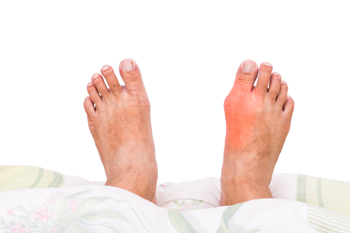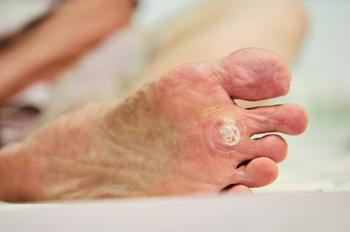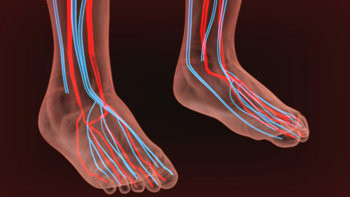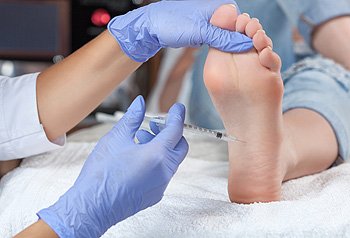 One of the first symptoms many patients experience with plantar fasciitis is heel pain. Additionally, discomfort can be felt in the arch area and may be pronounced after standing for extended periods of time throughout the day. This ailment is caused by an inflammation of the plantar fascia and can happen from wearing shoes that do not fit correctly. The plantar fascia is a band of tissue that is located on the sole of the foot, and connects the heels to the toes. Patients may find mild relief when the affected foot is massaged, and it may help to wear custom made orthotics. In severe cases, surgery may be a necessary option which may help to permanently relieve the pain. If you have developed plantar fasciitis, it is strongly recommended that you consult with a podiatrist who can provide expert treatment.
One of the first symptoms many patients experience with plantar fasciitis is heel pain. Additionally, discomfort can be felt in the arch area and may be pronounced after standing for extended periods of time throughout the day. This ailment is caused by an inflammation of the plantar fascia and can happen from wearing shoes that do not fit correctly. The plantar fascia is a band of tissue that is located on the sole of the foot, and connects the heels to the toes. Patients may find mild relief when the affected foot is massaged, and it may help to wear custom made orthotics. In severe cases, surgery may be a necessary option which may help to permanently relieve the pain. If you have developed plantar fasciitis, it is strongly recommended that you consult with a podiatrist who can provide expert treatment.
Plantar fasciitis is a common foot condition that is often caused by a strain injury. If you are experiencing heel pain or symptoms of plantar fasciitis, contact Dr. Richard DiMario from Maine. Our doctor can provide the care you need to keep you pain-free and on your feet.
What Is Plantar Fasciitis?
Plantar fasciitis is one of the most common causes of heel pain. The plantar fascia is a ligament that connects your heel to the front of your foot. When this ligament becomes inflamed, plantar fasciitis is the result. If you have plantar fasciitis you will have a stabbing pain that usually occurs with your first steps in the morning. As the day progresses and you walk around more, this pain will start to disappear, but it will return after long periods of standing or sitting.
What Causes Plantar Fasciitis?
There are some risk factors that may make you more likely to develop plantar fasciitis compared to others. The condition most commonly affects adults between the ages of 40 and 60. It also tends to affect people who are obese because the extra pounds result in extra stress being placed on the plantar fascia.
Prevention
There are a variety of treatment options available for plantar fasciitis along with the pain that accompanies it. Additionally, physical therapy is a very important component in the treatment process. It is important that you meet with your podiatrist to determine which treatment option is best for you.
If you have any questions, please feel free to contact our office located in York, ME . We offer the newest diagnostic and treatment technologies for all your foot care needs.
 Have you noticed a bump appear on the side of your big toe? If so, you may have developed a bunion. Bunions can be common among older women, however, they can affect anyone. Those affected by a bunion may experience pain, swelling, difficulty walking, a callus on or around the bunion, and a misshapen toe that leans inward, caused by the bunion. Symptoms generally worsen over time if left untreated, which is why it’s important to seek immediate care. If you believe you are experiencing symptoms of a bunion, please consult with a podiatrist for a proper diagnosis and advised treatment plan.
Have you noticed a bump appear on the side of your big toe? If so, you may have developed a bunion. Bunions can be common among older women, however, they can affect anyone. Those affected by a bunion may experience pain, swelling, difficulty walking, a callus on or around the bunion, and a misshapen toe that leans inward, caused by the bunion. Symptoms generally worsen over time if left untreated, which is why it’s important to seek immediate care. If you believe you are experiencing symptoms of a bunion, please consult with a podiatrist for a proper diagnosis and advised treatment plan.
If you are suffering from bunions, contact Dr. Richard DiMario of Maine. Our doctor can provide the care you need to keep you pain-free and on your feet.
What Is a Bunion?
A bunion is formed of swollen tissue or an enlargement of boney growth, usually located at the base joint of the toe that connects to the foot. The swelling occurs due to the bones in the big toe shifting inward, which impacts the other toes of the foot. This causes the area around the base of the big toe to become inflamed and painful.
Why Do Bunions Form?
Genetics – Susceptibility to bunions are often hereditary
Stress on the feet – Poorly fitted and uncomfortable footwear that places stress on feet, such as heels, can worsen existing bunions
How Are Bunions Diagnosed?
Doctors often perform two tests – blood tests and x-rays – when trying to diagnose bunions, especially in the early stages of development. Blood tests help determine if the foot pain is being caused by something else, such as arthritis, while x-rays provide a clear picture of your bone structure to your doctor.
How Are Bunions Treated?
If you have any questions, please feel free to contact our office located in York, ME . We offer the newest diagnostic and treatment technologies for all your foot care needs.
 A plantar wart is defined as a wart on the sole of the foot. It grows inward as a result of the pressure the feet endure on a daily basis, and can cause severe pain and discomfort. They appear to be flat, and many plantar warts have small, black specs in the center that are tiny blood vessels. Warts can be contagious, and are caused by a fungus that lives and thrives in warm and moist environments. These environments include public swimming pools, shower room floors, and surrounding areas. It is important to refrain from sharing shoes, socks, and towels, as this may limit the spread of plantar warts. There are effective treatment methods available, and it is suggested that you consult with a podiatrist who can determine which one is best for you.
A plantar wart is defined as a wart on the sole of the foot. It grows inward as a result of the pressure the feet endure on a daily basis, and can cause severe pain and discomfort. They appear to be flat, and many plantar warts have small, black specs in the center that are tiny blood vessels. Warts can be contagious, and are caused by a fungus that lives and thrives in warm and moist environments. These environments include public swimming pools, shower room floors, and surrounding areas. It is important to refrain from sharing shoes, socks, and towels, as this may limit the spread of plantar warts. There are effective treatment methods available, and it is suggested that you consult with a podiatrist who can determine which one is best for you.
Plantar warts can be very uncomfortable. If you need your feet checked, contact Dr. Richard DiMario from Maine. Our doctor will assist you with all of your foot and ankle needs.
About Plantar Warts
Plantar warts are the result of HPV, or human papillomavirus, getting into open wounds on the feet. They are mostly found on the heels or balls of the feet.
While plantar warts are generally harmless, those experiencing excessive pain or those suffering from diabetes or a compromised immune system require immediate medical care. Plantar warts are easily diagnosed, usually through scraping off a bit of rough skin or by getting a biopsy.
Symptoms
Treatment
To help prevent developing plantar warts, avoid walking barefoot over abrasive surfaces that can cause cuts or wounds for HPV to get into. Avoiding direct contact with other warts, as well as not picking or rubbing existing warts, can help prevent the further spread of plantar warts. However, if you think you have developed plantar warts, speak to your podiatrist. He or she can diagnose the warts on your feet and recommend the appropriate treatment options.
If you have any questions please feel free to contact our office located in York, ME . We offer the newest diagnostic and treatment technologies for all your foot and ankle needs.
Peripheral artery disease ( PAD) is a condition that causes poor blood flow to the lower extremities. This is due to a buildup of plaque along the walls of the arteries, causing them to narrow and become stiff and thus restricting blood flow. According to a recent study, people with rheumatoid arthritis (RA), an autoimmune disorder that affects the joints, appear to be at an increased risk of developing PAD. Fortunately, both PAD and RA can be managed. A podiatrist can screen for PAD and recommend treatment options for both conditions. If you have poor circulation to your lower limbs or arthritic joint pain in your feet and ankles, it is suggested that you consult with a podiatrist.
PAD) is a condition that causes poor blood flow to the lower extremities. This is due to a buildup of plaque along the walls of the arteries, causing them to narrow and become stiff and thus restricting blood flow. According to a recent study, people with rheumatoid arthritis (RA), an autoimmune disorder that affects the joints, appear to be at an increased risk of developing PAD. Fortunately, both PAD and RA can be managed. A podiatrist can screen for PAD and recommend treatment options for both conditions. If you have poor circulation to your lower limbs or arthritic joint pain in your feet and ankles, it is suggested that you consult with a podiatrist.
Peripheral artery disease can pose a serious risk to your health. It can increase the risk of stroke and heart attack. If you have symptoms of peripheral artery disease, consult with Dr. Richard DiMario from Maine. Our doctor will assess your condition and provide you with quality foot and ankle treatment.
Peripheral artery disease (PAD) is when arteries are constricted due to plaque (fatty deposits) build-up. This results in less blood flow to the legs and other extremities. The main cause of PAD is atherosclerosis, in which plaque builds up in the arteries.
Symptoms
Symptoms of PAD include:
It is important to note that a majority of individuals never show any symptoms of PAD.
Diagnosis
While PAD occurs in the legs and arteries, Podiatrists can diagnose PAD. Podiatrists utilize a test called an ankle-brachial index (ABI). An ABI test compares blood pressure in your arm to you ankle to see if any abnormality occurs. Ultrasound and imaging devices may also be used.
Treatment
Fortunately, lifestyle changes such as maintaining a healthy diet, exercising, managing cholesterol and blood sugar levels, and quitting smoking, can all treat PAD. Medications that prevent clots from occurring can be prescribed. Finally, in some cases, surgery may be recommended.
If you have any questions, please feel free to contact our office located in York, ME . We offer the newest diagnostic and treatment technologies for all your foot care needs.
 It can be easy to notice if you have flat feet. The entire foot will lie flat on the floor without a space where the arch would normally exist. The majority of babies are born with flat feet, and the arch typically develops at approximately six years of age. Patients who have flat feet may have an abnormal foot structure or weak muscle tone. Additionally, the ligaments may be loose, and this may be caused by genetic traits. Some of the symptoms that are associated with flat feet can include possible pain or tenderness in the foot, lack of energy, and it may be difficult to walk. The Achilles tendon may become inflamed, and foot conditions such as bunions may develop. It is advised for people who have flat feet to be under the care of a podiatrist who can offer effective relief methods, which may include wearing orthotics.
It can be easy to notice if you have flat feet. The entire foot will lie flat on the floor without a space where the arch would normally exist. The majority of babies are born with flat feet, and the arch typically develops at approximately six years of age. Patients who have flat feet may have an abnormal foot structure or weak muscle tone. Additionally, the ligaments may be loose, and this may be caused by genetic traits. Some of the symptoms that are associated with flat feet can include possible pain or tenderness in the foot, lack of energy, and it may be difficult to walk. The Achilles tendon may become inflamed, and foot conditions such as bunions may develop. It is advised for people who have flat feet to be under the care of a podiatrist who can offer effective relief methods, which may include wearing orthotics.
Flatfoot is a condition many people suffer from. If you have flat feet, contact Dr. Richard DiMario from Maine. Our doctor will treat your foot and ankle needs.
What Are Flat Feet?
Flatfoot is a condition in which the arch of the foot is depressed and the sole of the foot is almost completely in contact with the ground. About 20-30% of the population generally has flat feet because their arches never formed during growth.
Conditions & Problems:
Having flat feet makes it difficult to run or walk because of the stress placed on the ankles.
Alignment – The general alignment of your legs can be disrupted, because the ankles move inward which can cause major discomfort.
Knees – If you have complications with your knees, flat feet can be a contributor to arthritis in that area.
Symptoms
Treatment
If you are experiencing pain and stress on the foot you may weaken the posterior tibial tendon, which runs around the inside of the ankle.
If you have any questions please feel free to contact our office located in York, ME . We offer the newest diagnostic and treatment technologies for all your foot and ankle needs.
 Athlete’s foot, also known as tinea pedis, is a fungal infection of the skin on the feet. The types of fungus that cause athlete’s foot thrive in moist, warm, dark environments and multiply easily on irritated or weakened skin. Symptoms of this infection include itchy, sore, or scaling skin between the toes, and a burning sensation in the affected areas. Your feet may also develop an unpleasant smell. Left untreated, blisters may form on the feet and eventually break open, exposing raw skin and potentially leading to secondary bacterial infections. If you have athlete’s foot, it is recommended that you seek medical treatment, as this infection can also spread to other parts of the body. Consult with a podiatrist if you notice that you have symptoms of athlete’s foot.
Athlete’s foot, also known as tinea pedis, is a fungal infection of the skin on the feet. The types of fungus that cause athlete’s foot thrive in moist, warm, dark environments and multiply easily on irritated or weakened skin. Symptoms of this infection include itchy, sore, or scaling skin between the toes, and a burning sensation in the affected areas. Your feet may also develop an unpleasant smell. Left untreated, blisters may form on the feet and eventually break open, exposing raw skin and potentially leading to secondary bacterial infections. If you have athlete’s foot, it is recommended that you seek medical treatment, as this infection can also spread to other parts of the body. Consult with a podiatrist if you notice that you have symptoms of athlete’s foot.
Athlete’s foot is an inconvenient condition that can be easily reduced with the proper treatment. If you have any concerns about your feet and ankles, contact Dr. Richard DiMario from Maine. Our doctor will treat your foot and ankle needs.
Athlete’s Foot: The Sole Story
Athlete's foot, also known as tinea pedis, can be an extremely contagious foot infection. It is commonly contracted in public changing areas and bathrooms, dormitory style living quarters, around locker rooms and public swimming pools, or anywhere your feet often come into contact with other people.
Solutions to Combat Athlete’s Foot
Athlete’s foot can cause many irritating symptoms such as dry and flaking skin, itching, and redness. Some more severe symptoms can include bleeding and cracked skin, intense itching and burning, and even pain when walking. In the worst cases, Athlete’s foot can cause blistering as well. Speak to your podiatrist for a better understanding of the different causes of Athlete’s foot, as well as help in determining which treatment options are best for you.
If you have any questions please feel free to contact our office located in York, ME . We offer the newest diagnostic and treatment technologies for all your foot and ankle needs.
 Patients who have the medical condition that is known as plantar fasciitis are often familiar with the severe discomfort this ailment can cause. The pain that is associated with plantar fasciitis is felt in the heel and it can cause difficulty walking. Daily activities may be hard to complete as the day continues, and this can be a result of existing heel pain. This condition can gradually develop from standing for extended periods of time throughout the day, or from wearing shoes that do not fit properly. Moderate relief may be found when the affected foot is stretched. An effective stretch consists of rolling the sole of the foot on a golf ball, and this may help to alleviate a portion of the tension that is commonly associated with this type of foot pain. If you are experiencing any type of heel pain, it is suggested that you consult with a podiatrist as soon as possible who can properly diagnose plantar fasciitis and offer you the correct treatment options.
Patients who have the medical condition that is known as plantar fasciitis are often familiar with the severe discomfort this ailment can cause. The pain that is associated with plantar fasciitis is felt in the heel and it can cause difficulty walking. Daily activities may be hard to complete as the day continues, and this can be a result of existing heel pain. This condition can gradually develop from standing for extended periods of time throughout the day, or from wearing shoes that do not fit properly. Moderate relief may be found when the affected foot is stretched. An effective stretch consists of rolling the sole of the foot on a golf ball, and this may help to alleviate a portion of the tension that is commonly associated with this type of foot pain. If you are experiencing any type of heel pain, it is suggested that you consult with a podiatrist as soon as possible who can properly diagnose plantar fasciitis and offer you the correct treatment options.
Plantar fasciitis can be very painful and inconvenient. If you are experiencing heel pain or symptoms of plantar fasciitis, contact Dr. Richard DiMario from Maine. Our doctor can provide the care you need to keep you pain-free and on your feet.
What Is Plantar Fasciitis?
Plantar fasciitis is the inflammation of the thick band of tissue that runs along the bottom of your foot, known as the plantar fascia, and causes mild to severe heel pain.
What Causes Plantar Fasciitis?
How Can It Be Treated?
While very treatable, plantar fasciitis is definitely not something that should be ignored. Especially in severe cases, speaking to your doctor right away is highly recommended to avoid complications and severe heel pain. Your podiatrist can work with you to provide the appropriate treatment options tailored to your condition.
If you have any questions please feel free to contact our office located in York, ME . We offer the newest diagnostic and treatment technologies for all your foot and ankle needs.
 Cuboid syndrome is a condition caused by an injury to the joint and ligaments surrounding the cuboid bone, one of the seven tarsal bones of the foot. Injuries are typically the result of overuse or of spraining the ankle. Cuboid syndrome also appears to be more common in people with pronated, or inward-turned, feet. Symptoms of Cuboid syndrome include pain, swelling, bruising, skin redness and a decreased range of motion in the affected foot. Treatment typically begins at home with resting the foot, applying ice, and compressing and elevating the foot. If pain persists or worsens, schedule an appointment with a podiatrist, who can rule out other conditions, such as a fracture, and perform various treatments to relieve pain and restore function to the foot.
Cuboid syndrome is a condition caused by an injury to the joint and ligaments surrounding the cuboid bone, one of the seven tarsal bones of the foot. Injuries are typically the result of overuse or of spraining the ankle. Cuboid syndrome also appears to be more common in people with pronated, or inward-turned, feet. Symptoms of Cuboid syndrome include pain, swelling, bruising, skin redness and a decreased range of motion in the affected foot. Treatment typically begins at home with resting the foot, applying ice, and compressing and elevating the foot. If pain persists or worsens, schedule an appointment with a podiatrist, who can rule out other conditions, such as a fracture, and perform various treatments to relieve pain and restore function to the foot.
Cuboid syndrome, also known as cuboid subluxation, occurs when the joints and ligaments near the cuboid bone in the foot become torn. If you have cuboid syndrome, consult with Dr. Richard DiMario from Maine. Our doctor will assess your condition and provide you with quality foot and ankle treatment.
Cuboid syndrome is a common cause of lateral foot pain, which is pain on the outside of the foot. The condition may happen suddenly due to an ankle sprain, or it may develop slowly overtime from repetitive tension through the bone and surrounding structures.
Causes
The most common causes of cuboid syndrome include:
Symptoms
A common symptom of cuboid syndrome is pain along the outside of the foot which can be felt in the ankle and toes. This pain may create walking difficulties and may cause those with the condition to walk with a limp.
Diagnosis
Diagnosis of cuboid syndrome is often difficult, and it is often misdiagnosed. X-rays, MRIs and CT scans often fail to properly show the cuboid subluxation. Although there isn’t a specific test used to diagnose cuboid syndrome, your podiatrist will usually check if pain is felt while pressing firmly on the cuboid bone of your foot.
Treatment
Just as the range of causes varies widely, so do treatments. Some more common treatments are ice therapy, rest, exercise, taping, and orthotics.
If you have any questions, please feel free to contact our office located in York, ME . We offer the newest diagnostic and treatment technologies for all your foot care needs.